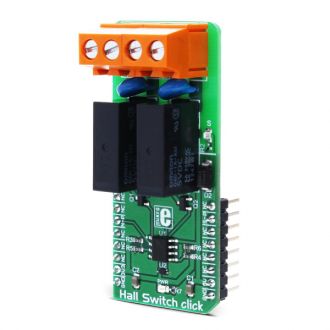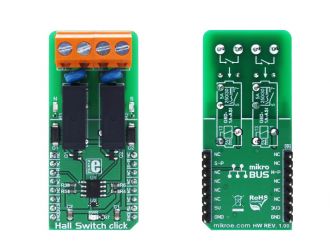
We strongly encourage users to use Package manager for sharing their code on Libstock website, because it boosts your efficiency and leaves the end user with no room for error. [more info]

Rating:
Author: MIKROE
Last Updated: 2018-04-12
Package Version: 1.0.0.0
mikroSDK Library: 1.0.0.0
Category: Magnetic
Downloaded: 5922 times
Not followed.
License: MIT license
Hall Switch click is a magnetic field activated dual-relay Click board. Hall Switch click has two high-quality relays, which are activated by the Hall-effect sensor.
Do you want to subscribe in order to receive notifications regarding "Hall Switch click" changes.
Do you want to unsubscribe in order to stop receiving notifications regarding "Hall Switch click" changes.
Do you want to report abuse regarding "Hall Switch click".


Library Description
The library carries two functions for poles control.
Key functions:
void hallswitch_setNpole(uint8_t state) - Set the state of N pole
void hallswitch_setSpole(uint8_t state) - Set the state of S pole
Examples Description
The application is composed of three sections:
void applicationTask()
{
hallswitch_setNpole(_HALLSWITCH_POLE_ACTIVE);
Delay_ms( 500 );
hallswitch_setSpole(_HALLSWITCH_POLE_ACTIVE);
Delay_ms( 500 );
hallswitch_setNpole(_HALLSWITCH_POLE_NO_ACTIVE);
Delay_ms( 500 );
hallswitch_setSpole(_HALLSWITCH_POLE_NO_ACTIVE);
Delay_ms( 500 );
}
Additional notes and information
Depending on the development board you are using, you may need USB UART click, USB UART 2 click or RS232 click to connect to your PC, for development systems with no UART to USB interface available on the board. The terminal available in all MikroElektronika compilers, or any other terminal application of your choice, can be used to read the message.